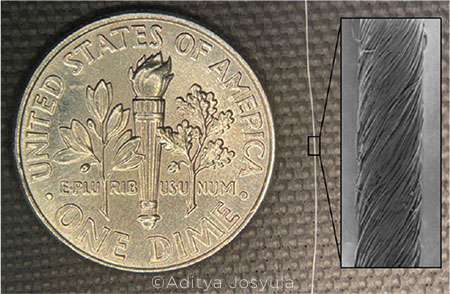Download PDF
By twisting nanometer-scale polymer strands into thin ropes, researchers at the Wilmer Eye Institute in Baltimore have found their way to what arguably represents a Holy Grail of ophthalmic surgery: a resilient ultrathin suture material capable of delivering an antibiotic to ocular wound sites for days or weeks.1
 |
COMPARISON. In this composite image, a 10-0 size antibiotic-eluting multifilament nanofiber suture is shown next to a U.S. dime. The high-resolution scanning electron microscopy image (right) shows nanoscale structural detail.
|
Tackling a challenge. Currently, the only globally marketed drug-eluting sutures are coated with the antibacterial and antifungal agent triclosan. Given their size (U.S.P. sizes 6-0 through 0), these triclosan-loaded sutures are used only in general surgery.1
In ophthalmology, the advent of ultrathin drug-loaded sutures could virtually vanquish a number of infection-control challenges, including poor patient compliance with topical eyedrops and suture-related infections. Moreover, the researchers wrote, they could “reduce the need for oral antibiotic use, decrease the risk of infection associated with implantable ocular devices, and serve as an alternative to the more than 12 million nylon sutures used [globally] in ocular procedures each year.”1
Starting with levofloxacin. The researchers reported on incorporating the broad-spectrum antibiotic levofloxacin into nanofibers made from polycaprolactone (PCL), which is a biocompatible polymer. But other tests, not yet published, have shown that the methodology also works with other antibiotics and with steroids, said co–corresponding author Laura M. Ensign, PhD, at Wilmer’s Nanomedicine Division.
Novel application of an old lab technique. The group chose PCL for the sutures because it degrades slowly over 12 to 24 months, making it usable for suturing corneal grafts, and because PCL is already a component of several medical products, including thicker general surgery sutures, Dr. Ensign said.
Early tests showed that levofloxacin could be loaded into single, extruded monofilaments, but this reduced their tensile strength to 10% of what is required for ophthalmic sutures, she said. Instead, the researchers created a new electrospinning process to produce and twist nanofibers together.
“Electrospinning is a very old lab technique. The idea is that you’re using a syringe system and voltage to shoot out polymer threads,” Dr. Ensign said. “The uniqueness of the way we set it up is that, instead of the fibers randomly shooting onto a flat plate, we collect them in a perpendicular fashion, and a rotating motor twists the fibers together to give you a strong, composite nano-fiber suture in the end.”
Finished product. The finished product consists of hundreds of levofloxacin-loaded nanofibers, twisted together 1,576 times to make 10-0 sutures that are 28 μm in diameter. According to the researchers, the new nanofiber sutures demonstrated biocompatibility comparable to conventional nylon sutures. In addition, they retained 96% of breaking strength over 31 days and delivered levofloxacin at detectable levels in rat eyes for at least 30 days.1
The team also evaluated their manufacturing platform’s ability to produce sutures equivalent in size to 9-0 and 8-0 ophthalmic sutures.
What’s next? Several Wilmer surgeons are now testing the sutures’ ease of use in a wet lab, and, with the right investment, clinical testing could begin within two years, Dr. Ensign said. “We really want to make something that works as well as nylon and that the surgeon can actually enjoy using,” she said. “We don’t want a product that doesn’t do what the surgeon needs.”
—Linda Roach
___________________________
1 Parikh KS et al. Bioeng Transl Med. 2021;6(2): e10204.
___________________________
Relevant financial disclosures—Dr. Ensign: Co-inventor on patent applications describing the suture technology; Research to Prevent Blindness: S; Robert H. Smith Family Foundation: S.
For full disclosures and the disclosure key, see below.
Full Financial Disclosures
Dr. Ensign Co-inventor on patent applications describing the suture technology; Robert H. Smith Family Foundation: S; Research to Prevent Blindness: S; National Institutes of Health: S; National Science Foundation: S.
Dr. Hedges None.
Dr. Kokame Allergan: C; Bayer: C,L; Bausch + Lomb: C,L; Carl Zeiss: C,L; Genentech: C,S; Novartis: S; Regeneron: C,L,S; RegenxBio: S; Salutaris: S.
Dr. Reddy Alimera: C; Clearside: C; Eyepoint: C; Heidelberg: C.
Disclosure Category
|
Code
|
Description
|
| Consultant/Advisor |
C |
Consultant fee, paid advisory boards, or fees for attending a meeting. |
| Employee |
E |
Employed by a commercial company. |
| Speakers bureau |
L |
Lecture fees or honoraria, travel fees or reimbursements when speaking at the invitation of a commercial company. |
| Equity owner |
O |
Equity ownership/stock options in publicly or privately traded firms, excluding mutual funds. |
| Patents/Royalty |
P |
Patents and/or royalties for intellectual property. |
| Grant support |
S |
Grant support or other financial support to the investigator from all sources, including research support from government agencies (e.g., NIH), foundations, device manufacturers, and/or pharmaceutical companies. |
|
More from this month’s News in Review